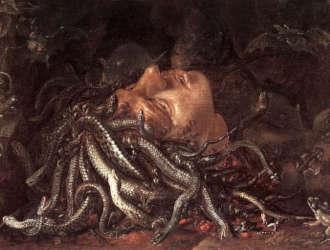Medusa and the Gorgons
Medusa was one of the three Gorgons, descendants of primordial sea deities Ceto and Phorcys, both related to the dangers of the sea such as deep waters and sea-monsters. Medusa was mortal unlike her sisters Stheno and Euryale who were immortal and sparred from aging. They were described, by Apollodorus, as having dragon scales all over their heads, swine-like tusks, brazen hands and golden wings and would turn anyone who looked at them to stone. They also had snakes instead of hair, some authors, however, are attributing this trait only to Medusa. It is said that they had three more sisters but of different species called Graeae (Graiae) who were said to be the guardians of the Gorgons. Both the Gorgons and Graeae had their dwelling place in Lybia, near lake Tritonis.
Medusa punished for her beauty
According to Ovid's Metamorphoses, Medusa was originally a beautiful maiden, mostly renowned for her stunning hair as it is said this was the most wonderful of her charms. She had many suitors and because of her beauty, she was violated by Poseidon in Athena's temple. Athena punished Medusa by transforming her hair to living snakes. It seems that Medusa was already a gorgon and had the ability to turn anyone to stone with her gaze because it is said that even Athena, while enraged, turned her head away and held her shield before her eyes during transformation.
Defeated by Perseus
According to Apollodrus's Library, the story began when king Polydectes had fallen in love with Danae and found Perseus as the main obstacle for their marriage. The king ordered him to bring the head of Medusa, thinking it would be his downfall because of the difficulty of the task which was not impossible since Medusa was mortal but was also extremly lethal. However, the hero was aided by Hermes and Athena and made way to Graeae and stole the one eye and one tooth from them and held it for ransom to divulge the location of the nymphs, believed to be Hesperides, daughters of Atlas. The nymphs gave the hero winged sandals, cap of invisibility of Hades and kibisis, a sack or a wallet to contain the head of Medusa. Perseus also received adamantine sickle from Hermes before being guided by Athena to the lair. It is said that he was using her shield's reflection for orientation, to avoid Medusa's deadly gaze, when striking for the head. Alternatively, according to Hyginus, Perseus is given, directly from Hermes, Talaria, winged sandals of Hermes, and Petasus, winged hat of Hermes, and Hades' cap of invisibility. He also received adamantine knife from Hephaestus. Perseus, fully equipped, arrived at the area and first had to deal with Graeae, he stole the one eye they had and threw it in lake Tritonis and, once the guardinas were blinded, accessed the lair where he decapitated Medusa while she was sleeping. It is said that from Medusa's blood sprang two creatures, Pegasus, the winged horse, and Chrysaor, a giant and that Poseidon is their father. According to Nonnus, this event had awakened other sisters Stheno and Euryale but Perseus escaped the lair immediately, being invisible and using winged sandals.
It is said that he was using her shield's reflection for orientation, to avoid Medusa's deadly gaze, when striking for the head. Alternatively, according to Hyginus, Perseus is given, directly from Hermes, Talaria, winged sandals of Hermes, and Petasus, winged hat of Hermes, and Hades' cap of invisibility. He also received adamantine knife from Hephaestus. Perseus, fully equipped, arrived at the area and first had to deal with Graeae, he stole the one eye they had and threw it in lake Tritonis and, once the guardinas were blinded, accessed the lair where he decapitated Medusa while she was sleeping. It is said that from Medusa's blood sprang two creatures, Pegasus, the winged horse, and Chrysaor, a giant and that Poseidon is their father. According to Nonnus, this event had awakened other sisters Stheno and Euryale but Perseus escaped the lair immediately, being invisible and using winged sandals.
Medusa's Head as a symbol
It is said that Perseus then took Medusa's head, which retained its petrifying power, and used it as a weapon in later adventures. Medusa's head was eventually given to Athena, who placed it on her shield (the Aegis) or, alternatively, according to Hyginus, on her breastplate. The aegis is decribed as a marvel to the Gods, most fearful when equipped with the head of Medusa, with strong serpents breathing forth the blast of ravening fire. It became a symbol of protection and power and was used on shields, breastplates and other pieces of armor by Greek warriors.